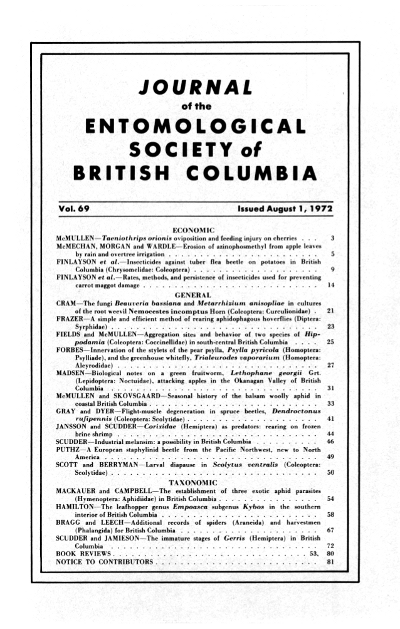Insecticides against tuber flea beetle on potatoes in British Columbia (Chrysomelidae: Coleoptera)
Keywords:
Chrysomelidae, Coleoptera, tuber flea beetle, potatoesAbstract
To protect potatoes from damage by larvae of the tuber flea beetle, <i>Epitrix tuberis</i> Gent., in silt and sandy clay loam soils, carbofuran (Furadan), fensulfothion (Dasanit), and fonofos (Dyfonate) were applied as 12-inch band or broadcast treatments, rotovated to a depth of 4 inches and rows of potatoes planted in the treated areas. Three supplementary drenches were applied at about 2-week intervals to include the emergence period of the second generation adults. In silt loam the untreated and fonofos band-treated plots produced 31 and 40% marketable tubers, respectively, against 92 to 100% for the other treatments. In sandy loam the comparable figures were 0.5 and 4.5% against 10 to 97%. Residues in the tubers ranged from none detected in fonofos treatments to 0.23 ppm of fensufothion and its sulfone in potatoes from the band treatment.References
Banham, F.L. 1960. Soil insecticides for control of the tuber flea beetle, Epitrix tuberis Gent. in the interior of British Columbia. Can. J. Plant Sci. 40:165-171.
Banham, F.L. 1965. Control experiments using soil-incorporated insecticides. Pesticide Res. Report (Can. Dept. Agr., Ottawa). 102-104.
Banham F.L. 1967. Control experiments using soil-incorporated insecticides. Ibid.1:221-122.
Banham, F.L. 1968. Field trials of soil-incorporated insecticides against the tuber flea beetle. Ibid. 126-127.
Banham, F.L. and D.G. Finlayson. 1967. Resistance to organochlorine insecticides in the tuber flea beetle, Epitrix tuberis Gent. (Coleoptera: Chrysomelidae). In British Columbia J. Entomol. Soc. Brit. Columbia. 64:17-22.
Cook, R.F., R.P. Stanovick, and C.C. Cassil. 1969. Determination of carbofuran and its carbamate metabolite residues in corn using a nitrogen-specific gas chromatographic
detector. J. Agr. Food Chem. 17:277-282.
Duncan, D.B. 1955. Multiple range and multiple F tests. Biometrics 11:1-42.
Finlayson, D.G. and C.L. Neilson. 1954. Experiments on the insecticidal control of the tuber flea beetle, Epitrix tuberis Gent., in the interior of British Columbia. Can. J. Agr. Sci. 34:156-160.
Fulton, H.G. and F.L. Banham. 1960. A brief historv of the tuber flea beetle, Epitrix tuberis Gent., in British Columbia. Proc. Entomol. Soc. Brit. Columbia 57:47-49.
Glendenning, R. 1945. The tuber flea beetle in British Columbia and its control. Can. Dept. Agr. Publ. 22 (Processed).
Neilson, C.L. and D.C. Finlayson. 1954. Notes on the biology of the tuber flea beetle, Epitrix tuberis Gentner (Coleoptera: Chnryomelidae) in the interior of British Columbi a. Can. Ent. 85:31-32.
Wilkinson, A.T.S. 1968. Chemical control of wireworms. Pesticide Res. Report (Can. Dept. Agr., Ottawa). 99-100.
Wilkinson, A.T.S. 1969. Chemical control of wireworms. Ibid. 121-122.
Williams, I.H., R. Kore and D.C. Finlayson. 1971. Determination of residues of Dasanit and three metabolites by gas chromatographv with flame photometric detection. J. Agr. Food Chem. 19:456-458.
Downloads
Published
Issue
Section
License
Authors who publish with the Journal of the Entomological Society of British Columbia agree to the following terms:
-Authors retain copyright and grant the journal right of first publication with the work simultaneously licensed under a Creative Commons Attribution License that allows others to share the work with an acknowledgement of the work's authorship and initial publication in this journal.
-Authors are able to enter into separate, additional contractual arrangements for the non-exclusive distribution of the journal's published version of the work (e.g., post it to an institutional repository or publish it in a book), with an acknowledgement of its initial publication in this journal.
-Authors are permitted and encouraged to post their work online (e.g., in institutional repositories or on their website) prior to and during the submission process, as it can lead to productive exchanges, as well as earlier and greater citation of published work (See The Effect of Open Access).


